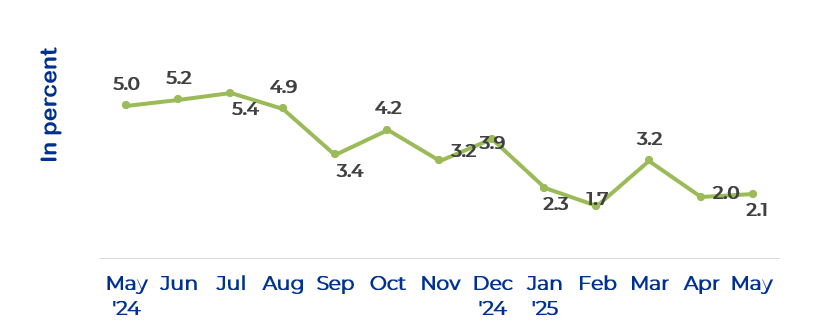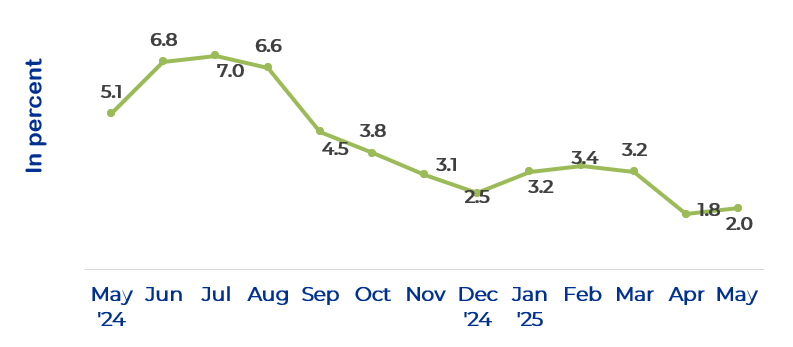Table 1. Year-on-Year Inflation Rate for Bottom 30% Income Households, All Items (2018=100) in percent
| Area | May 2024 | April 2025 | May 2025 | Year-to-Date |
| Philippines | 5.3 | 0.1 | 0.0 | 1.0 |
| Negros Island Region | 5.0 | 1.3 | 1.3 | 1.6 |
| Negros Occidental | 5.0 | 2.0 | 2.1 | 2.2 |
| Bacolod City | 5.1 | 1.8 | 2.0 | 2.7 |
Source: Philippine Statistics Authority, Retail Price Survey of Commodities for the Generation of Consumer Price Index
Figure 1. Inflation Rates for the Bottom 30% Income Households in the province of Negros Occidental, All Items (2018=100)

Source: Philippine Statistics Authority, Retail Price Survey of Commodities for the Generation of Consumer Price Index
A. Negros Occidental
Highlights of the press conference includes the Bottom 30% Income Households in Negros Occidental increased to 2.1% in May from 2.0% in April 2025. In May 2024, the inflation rate was posted at 5.0% (Please see Table 1 and Figure 1).
For Negros Occidental Bottom 30% Income Households, the following commodity groups were the top three main sources of acceleration of the May 2025 inflation:
a. Food and Non-Alcoholic Beverages at 1.3% inflation in May from 1.4% inflation in April 2025, with 36.1% share,
b. Housing, Water, Electricity, Gas and Other Fuels at 4.2% inflation in May from 2.1% inflation in April 2025, with 25.2% share,
c. Alcoholic Beverages and Tobacco at 8.3% inflation in May from 9.3% inflation in April 2025, with 18.9% share.
Meanwhile, the top one major contributor of the May 2025 inflation for Bottom 30% Income Households in Negros Occidental is:
a. Housing, Water, Electricity, Gas and Other Fuels at 4.2% inflation in May from 2.1% inflation in April 2025, with 96.3% share.
Figure 2. Inflation Rates for the Bottom 30% Income Households in
Bacolod City, All Items (2018=100)

Source: Philippine Statistics Authority, Retail Price Survey of Commodities for the Generation of Consumer Price Index
B. Bacolod City
Meanwhile, for the Bottom 30% Income Households in Bacolod City increased to 2.0% in May from 1.8% in April 2025. In May 2024, the inflation rate was posted at 5.8% (Please see Table 1 and Figure 2).
For Bacolod City Bottom 30% Income Households, the following commodity groups were the top three main sources of acceleration of the May 2025 inflation:
a. Restaurants and Accommodation at 6.2% inflation in both May and April 2025, with 27.4% share,
b. Housing, Water, Electricity, Gas and Other Fuels at 2.4% inflation in May from 1.3% inflation in April 2025, with 17.8% share,
c. Food and Non-Alcoholic Beverages at 0.7% inflation in May from 0.5% inflation in April 2025, with 16.9% share.
Meanwhile, the top two major contributors of the May 2025 inflation for Bottom 30% Income Households in Bacolod City are:
a. Housing, Water, Electricity, Gas and Other Fuels at 2.4% inflation in May from 1.3% inflation in April 2025, with 59.9% share,
b. Food and Non-Alcoholic Beverages at 0.7% inflation in May from 0.5% inflation in April 2025, with 32.1% share,
Moreover, the fifth Press Conference for the year 2025 on Inflation Report of Negros Occidental and Bacolod City garnered support from the public and media personnel who watched the online livestream through the PSA Negros Occidental official Facebook page https://www.facebook.com/psa0645negocc and Google Meet Link https://meet.google.com/gpc-emxu-fdd using the hashtag #NegOccBCDCPI. With this, PSA Negros Occidental is set to the conduct the Press Conference on Inflation every month.
DEFINITION OF TERMS AND CONCEPT USED:
Consumer Price Index (CPI) is a measure of change in the average retail prices of a fixed basket of commodities or goods and services commonly purchased by the households relative to a base year or base period.
Base year or base period is a reference period, usually a year, at which the index number is set to 100. It is the reference point of the index number series.
Inflation rate refers to the annual rate of change or the year-on-year change of the CPI expressed in percentage.
The inflation rate can be positive or negative (deflation). A positive inflation rate means that the prices of commodities have increased compared with their prices in the previous year. Negative inflation means that the prices of commodities have decreased compared with their prices in the previous year.
A positive but lower inflation rate compared to the previous month’s inflation rate means that the prices of commodities for the current month have increased year-on-year but at a slower rate than the year-on-year increase in the previous month. It does not mean that the prices of commodities have decreased.
Bottom 30% Income Households – The CPI for the bottom 30% income households is compiled by the PSA to measure the changes of prices of commodities commonly purchased by the families that belong to the bottom 30% income decile. The process of price collection and CPI computation is the same as that of the CPI for all income households. However, there is a separate market basket and weights for the CPI for the bottom 30% income households.
Purchasing Power of Peso (PPP) is a measure of the real value of the peso in a given period relative to the base period.
Source: psa.gov.ph
Approved for release:
SGD JOHN F. CAMPOMANES
(Chief Statistical Specialist)
Interim Regional Director
SAT/LMG

